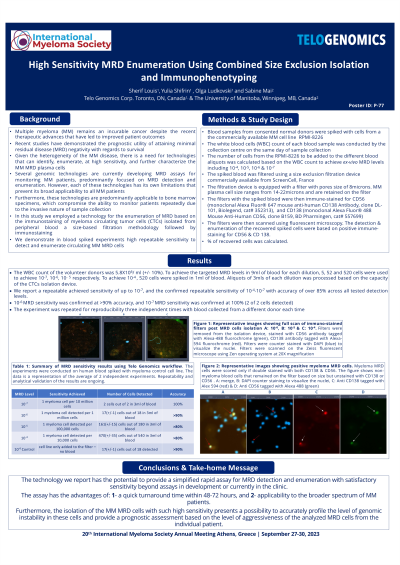MRD Assessment and role in Myeloma
Poster Session 1
P-077: High Sensitivity MRD Enumeration Using Combined Size Exclusion Isolation and Immunophenotyping
Wednesday, September 27, 2023
1:30 PM - 2:30 PM EEST


Sherif Louis, PhD, MSc, PMP (he/him/his)
President and CTO
Telo Genomics Corp.
Toronto, Ontario, Canada
Introduction: Despite the many therapeutic advances in the field of multiple myeloma (MM) that have led to improved outcomes for these patients, MM remains an incurable cancer. Several studies and most recently, a large scale, pooled analysis of patients from 4 large randomized controlled studies have demonstrated the prognostic utility of attaining minimal residual disease (MRD) negativity with regards to survival. Given the understanding of how heterogeneous the disease is, there is a need to develop technologies that can identify and enumerate MM MRD plasma cells with superior sensitivity, and further characterize the residual clones, thereby profiling them as high, mid or low risk clones. Currently, ongoing trials that are designed to escalate or de-escalate therapy based on MRD status fail to take into consideration the fact that MRD status carries different significance based on the risk profile of any given patient.
Several genomic technologies are currently developing MRD assays for post treatment MM patients. These technologies are predominantly focused on MRD detection, and the enumeration of MRD plasma cells. However, each of these technologies, whether in development or in the clinic, has its own technical limitations that prevent the broad applicability of the technology to all MM patients. Furthermore, these technologies are predominantly applicable to bone marrow specimens, which compromise the main utility of MRD, which is to monitor patients repeatedly over time, due to the invasive nature of bone marrow sample collection procedures.
Methods: We employed a technology for the enumeration of MRD based on the immunostaining of isolated circulating myeloma plasma cells (CTCs) from peripheral blood. The assay deploys a size-based filtration methodology that recovers CTCs from the patient’s blood sample. This is followed by immunostaining, fluorescence three-dimensional (3D) microscopy and automated immunophenotyping detection and enumeration of the MRD plasma cells.
Results: We report our proof of principle results from spiking experiments where blood samples from consented normal donors were spiked with cells from a characterized and commercially available MM cell line. We report a repeatable achieved sensitivity of up to 10-7 and the confirmed repeatable sensitivity of 10-4-10-7 with accuracy of over 85% across all tested detection levels.
Conclusions: The technology has the potential to provide a simplified rapid assay for MRD detection and enumeration with satisfactory sensitivity beyond assays in development or currently in the clinic. The assay has the advantages of: 1- a quick turnaround time within 48-72 hours, and 2- applicability to the broader spectrum of MM patients. Furthermore, the isolation of the MM MRD cells with such high sensitivity presents a possibility to accurately profile the level of genomic instability in these cells and provide a prognostic assessment based on the level of aggressiveness of the analyzed MRD cells from the individual patient.
Several genomic technologies are currently developing MRD assays for post treatment MM patients. These technologies are predominantly focused on MRD detection, and the enumeration of MRD plasma cells. However, each of these technologies, whether in development or in the clinic, has its own technical limitations that prevent the broad applicability of the technology to all MM patients. Furthermore, these technologies are predominantly applicable to bone marrow specimens, which compromise the main utility of MRD, which is to monitor patients repeatedly over time, due to the invasive nature of bone marrow sample collection procedures.
Methods: We employed a technology for the enumeration of MRD based on the immunostaining of isolated circulating myeloma plasma cells (CTCs) from peripheral blood. The assay deploys a size-based filtration methodology that recovers CTCs from the patient’s blood sample. This is followed by immunostaining, fluorescence three-dimensional (3D) microscopy and automated immunophenotyping detection and enumeration of the MRD plasma cells.
Results: We report our proof of principle results from spiking experiments where blood samples from consented normal donors were spiked with cells from a characterized and commercially available MM cell line. We report a repeatable achieved sensitivity of up to 10-7 and the confirmed repeatable sensitivity of 10-4-10-7 with accuracy of over 85% across all tested detection levels.
Conclusions: The technology has the potential to provide a simplified rapid assay for MRD detection and enumeration with satisfactory sensitivity beyond assays in development or currently in the clinic. The assay has the advantages of: 1- a quick turnaround time within 48-72 hours, and 2- applicability to the broader spectrum of MM patients. Furthermore, the isolation of the MM MRD cells with such high sensitivity presents a possibility to accurately profile the level of genomic instability in these cells and provide a prognostic assessment based on the level of aggressiveness of the analyzed MRD cells from the individual patient.
